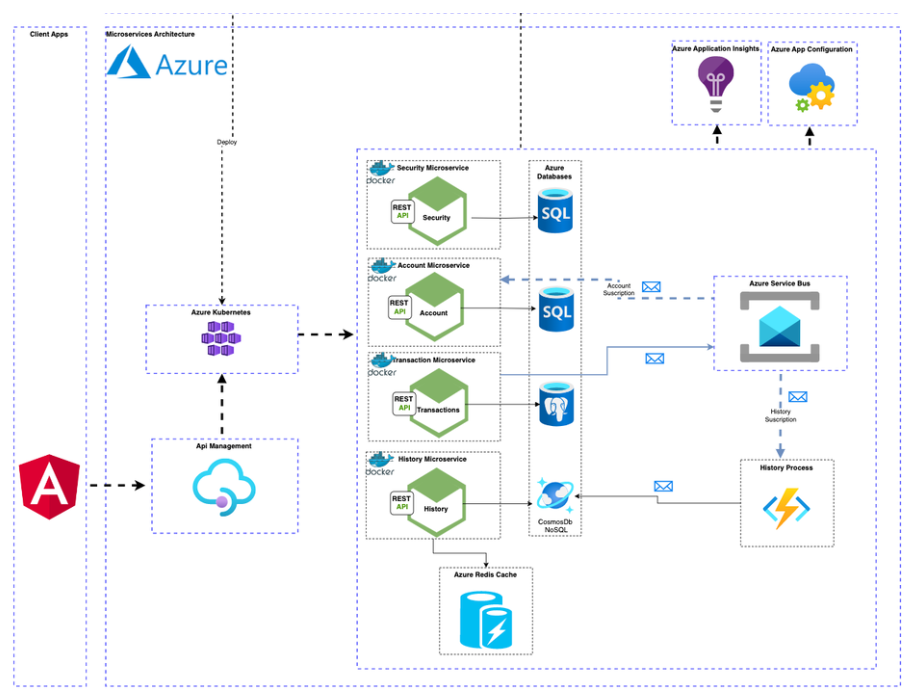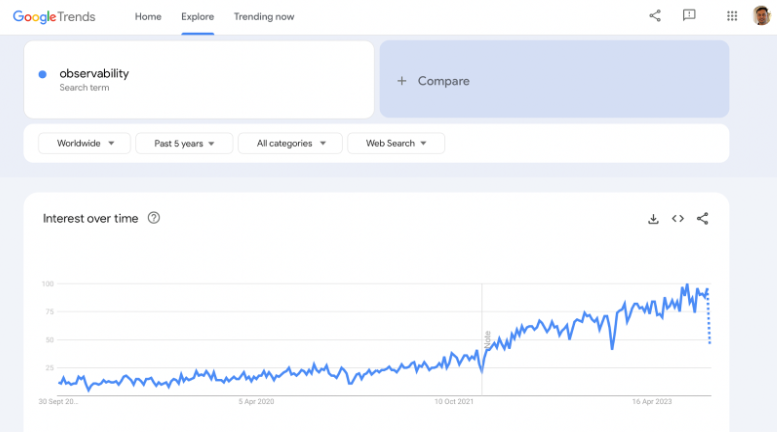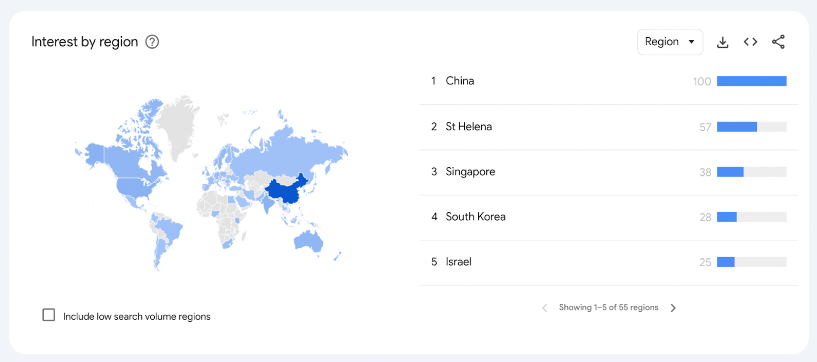In today’s high-tech world, computer systems are like big teams of machines that talk to each other, no matter where they are. They have to work together smoothly, or else things might go wrong. Think of it like a team sport – if one player messes up, it can affect the whole team’s performance. In distributed, interconnected IT systems, you have many components interacting with one another. Let’s take a look at the solution architecture below.

This includes a front-end, a variety of microservices deployed on Kubernetes, messaging services, caching, multiple databases, and numerous managed services. However, this is just a basic illustration. In reality, such an architecture can encompass hundreds, or even thousands, of components. It is crucial to keep an eye on all these components because if one of them experiences a failure or issue, it can have cascading effects on overall performance. This can then lead to minor or major problems, resulting in downtime and potentially harming the brand’s reputation. In complex systems, even minor changes can have far-reaching impacts on various components and services. Consequently, companies are making investments in observability for their systems to proactively prevent unfavorable situations in the future. Therefore, Observability is indeed a valuable solution for every brand working in the digital space.. It helps organizations gain insights into the performance and behavior of their systems, applications and infrastructure.
Developments in observability over the past five years


Source: Google Trends
- China has the highest search interest, St. Helena has a score of 48, Singapore, South Korea, Israel, and the United States have scores of 41, 29, 27, and 20, respectively, indicating their respective levels of search interest.
- India, Ireland, Canada, Australia, New Zealand, Hong Kong, Netherlands, Portugal, and Switzerland all have scores of 19 or lower, showing varying degrees of interest in ‘Observability’.
In summary, this trend offers insights into how countries differ in their search interest for ‘Observability.’ This data can be beneficial for multiple purposes, including gaining insights into regional interests and tailoring marketing strategies. Additionally, it’s noteworthy that the trend is displaying an upward trajectory. Next, we will explore the key factors contributing to this increasing demand.
The primary factors that are driving demand
Complexity of software systems
As already mentioned in the beginning, software systems have become increasingly complex with the adoption of microservices architectures, containerization, and cloud-native technologies. These distributed systems consist of numerous interconnected components, making it challenging to identify and diagnose issues without robust observability tools.
Shift to DevOps and SRE practices
The DevOps and Site Reliability Engineering (SRE) movements have gained traction, emphasizing collaboration between development and operations teams and the need for automated, data-driven approaches to managing systems. Observability plays a crucial role in these practices, providing the necessary data for continuous improvement and faster incident response.
Demand for real-time insights
Users and organizations now expect applications to be available 24/7 with minimal downtime. To meet these expectations, they need real-time insights into system performance and issues. Observability tools offer real-time data and analytics to help meet these demands.
Increased Adoption of Cloud Services
As more organizations migrate to cloud-based infrastructures, they often lack the same level of visibility they had in traditional on-premises environments. Observability solutions can bridge this gap by providing insights into the performance of cloud-hosted services and applications.
Growing emphasis on customer experience
Businesses are more customer-centric than ever before. Poor application performance can directly impact user experience and customer satisfaction. Observability helps organizations proactively address issues before they impact customers.
Regulatory and compliance requirements
Various industries, such as finance and healthcare, are subject to stringent regulatory requirements. Observability tools assist in ensuring compliance by providing visibility into system behavior and data handling.
Increased competition
In a competitive market, organizations are constantly striving to improve their products and services. Observability enables companies to gather insights into how their software is used and perform, helping them make data-driven decisions for optimization and innovation.
Cybersecurity concerns
As cyberattacks become more frequent and sophisticated, observability tools take on a vital role in the detection and quick response to security incidents. Vigilantly monitoring for any suspicious activities forms an integral component of cybersecurity observability.
What is the solution?
Now, Determining whether you should introduce observability into your digital environment encompasses several critical considerations. Factors such as your business objectives, infrastructure evaluation, past incidents, regulatory needs, and future expansion plans play a pivotal role in this decision-making process.
Notably, Devoteam boasts a dedicated Innovative Technology team, which can significantly contribute to unlocking your cloud potential and accelerating your business growth. Their various Elastic Stack solutions, which includes Elasticsearch, Logstash, Kibana, APM, Beats and Machine Learning, can significantly enhance observability for companies operating in the digital space. Here’s how they can help:
- Log and Data Aggregation: One of the solutions is centralized log data, metrics, and other observability data from various sources across your digital infrastructure. This enables a unified view of your systems and applications, making it easier to monitor and troubleshoot issues.
- Real-time Monitoring: Get real-time insights into system performance, user activity, and application behavior using Kibana dashboards and visualizations solutions.
- Alerting and Anomaly Detection: Elastic Stack solutions allows you to set up alerts based on predefined thresholds or anomalies. This means you can proactively identify and respond to issues before they impact your users.
- Tracing and Distributed Tracing: With the addition of Elastic APM (Application Performance Monitoring), you can trace requests as they move through your application stack. This helps in identifying performance bottlenecks and understanding the end-user experience.
- Elastic Security and Compliance: Elastic Stack can be used for security observability, enabling you to detect and investigate security threats and maintain compliance with data protection regulations for example Security Information and Event Management, Endpoint Security, Threat Detection and Investigation, Security Analytics, etc.
- Scalability, Data Retention and Storage: Elastic Stack is designed to scale horizontally, accommodating growing data volumes as your company expands. This is crucial for companies experiencing rapid growth in the digital space. Because of this it makes storage of data for extended periods without any worry, making it a best solution to perform historical analysis and compliance reporting.
- Elasticsearch Search Engine: Elasticsearch, at the core of Elastic Stack, provides powerful full-text search capabilities making it easy to search through any data to find the information in real time.
- Do You Need a More Customized solution? This is the best part, Elastic Stack is highly configurable and customizable, allowing you to tailor it to your specific observability needs.
Conclusion
Overall, we can understand that the Elastic Stack provides a comprehensive observability solution that enables companies in the digital space to monitor, analyze, and troubleshoot their systems and applications effectively. It is especially valuable for any company seeking to maintain reliability and make data-driven decisions to ensure their ongoing success.
Now this blog is coming to an end. I want to express my sincere appreciation for taking the time to explore this blog. I truly hope you found it informative and valuable. Your engagement means a lot, and I’m here to assist with any questions or further discussions on this topic. Your feedback is highly encouraged, and I’d love to hear your thoughts on observability in the comments below.
If you’d like to explore more of my previous blogs, please click on the following links:
- Mastering Elastic DSL: Essential Queries Every Elastic Developer Should Master
- Unlocking the Power of Elasticsearch Search Templates
Your continued interest and support are greatly appreciated and don’t forget to post your comments or any feedback if you have.